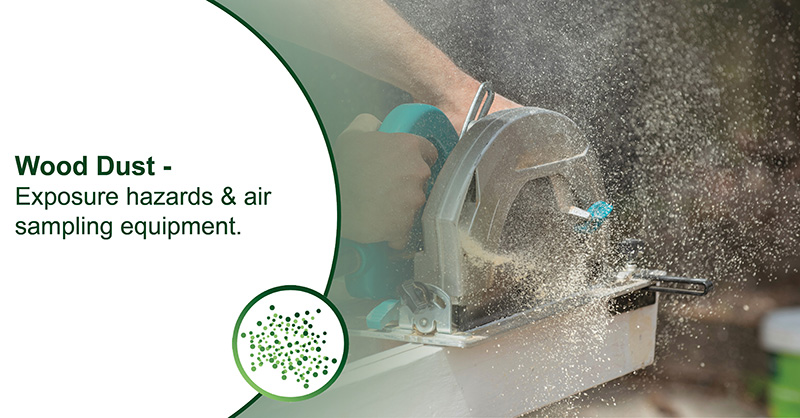Casella UK
Wolseley Rd, Kempston,Bedford MK42 7JY
+44(0)1234844100
info@casellasolutions.com

Air Sampling for Wood Dust: What’s involved?
In this article we will discuss wood dust and introduce the principles of air sampling and the equipment that can be used to measure exposure.
Wood dust is a substance hazardous to health, potentially causing skin disorders, asthma, rhinitis, and a rare type of nasal cancer. Wood dust is produced when the material is processed, and the quantity and type of the exposure problem will depend on how it's processed. Types of activity that can produce high dust exposures over a long period of time include machining operations such as sanding by machine, or hand assembly of machined items, or bagging of dust from extraction systems. Bad housekeeping is an issue, where people may use compressed airlines or sweeping to clean up, which should always be avoided, and a vacuum cleaner used.
These health hazards are covered by regulations, where exposure limits are typically set separately for hardwoods and softwood. There is a duty of care and a need to carry out a suitable risk assessment, ultimately to prevent exposure or adequately control it.
If there's a known problem with dust exposure, then you should do something about it by controlling it at source. As part of the risk assessment if you have significant risk of exposure and want to quantify what the dust levels are then personal air sampling is a method to do so.
Exposure limits for hardwoods and softwoods vary depending on the location in the world, for example in the UK both hardwood and softwood dusts have a Workplace Exposure Limit (WEL):
- The WEL for hardwood dust is 3mg/m3 (based on an 8-hour time-weighted average).
- The WEL for softwood dust is 5mg/m3 (based on an 8-hour time-weighted average).
Exposure limits can be as low as 1mg/m3 in some countries, so check your local limits. These are personal exposures, so they are the exposure of an individual and therefore the preferred method for air sampling is using a personal air sampling pump.
Air sampling, what is involved?
Air sampling involves wearing a personal air sampling pump, generally on the belt and this draws in volume of air with a very accurate flow, so that the total volume of air sampled is know. The pump is connected via a tube to a sampling head in the breathing zone, that is within 30 centimetres of the nose and mouth. The sampling head contains a filter, where the filter is weighed before sampling. Use a recognised laboratory, with an accurate weighing scale that can weigh down to a few milligrams. Generally, the pump is worn for the workers entire shift so that it samples the complete exposure. Once sampling is complete the filter is weighed again, so the difference in the weight of the filter is the weight of dust. In combination with the volume of air sampled the concentration of dust can be calculated, then subsequently the exposure levels, which can be compared to permissible or recommended exposure levels.
To establish what flow rate to use, which sampling head to select and what filter media then refer to the relevant method provided locally. There is a level of competence required for air sampling to ensure an accurate sample is taken. For example, understanding how to handle filters, setting up the pumps and calibrating are all important factors to make sure you get a highly accurate sample.

When selecting an air sampling pump ensure the following items are taken into consideration:
- The pump conforms to ISO 13137 which is the international standard for air sampling pumps.
- The pump is capable of flows greater than two litres a minute as that's mostly where sampling for word dust occurs.
- It's light and comfortable to wear for the worker, you want to make sure that the employee wears it for the whole day.
- It's robust and capable of the harsh environments so has a good Ingress protection (IP) rating.
- That the pump is intrinsically safe, if it is potentially going to be used in flammable atmospheres
Make sure that you also get all of the relevant equipment needed to do your sampling such as a flow meter to calibrate the pump and the relevant sampling heads, tube and other accessories. Personal sampling using a recognised method will ensure that you get accurate exposure assessments, and confidence in results.
Other instruments
Personal air sampling is the perfect tool to get accurate assessments of an individuals 8-hour exposure. However, they can only provide an average. Other instruments such as real time dust meters can help fill the gaps as to when exposure occurred. Real time instruments can:
- Allow a walk-through survey so problem areas can be easily identified and exposed workers prioritised accordingly.
- Be left in an area to see when exposure is occurring. Are specific events and processes responsible for significant levels of overall exposure?
- Check on the effectiveness of control measures and instantly check the effects of process changes.
- Provide instant results, you don’t need to wait for a laboratory to weigh a sample. So if you have issues around dust on a specific day, they can be checked.
- Be used as a training tool, show operators what they are exposed to, making them aware of the risk and illustrate how their activity changes dust levels.

Summary
Wood dust is a significant risk to a worker’s health. Air sampling is a way to quantify exposure or measure residual risk and ensure control measures are effective. Personal sampling pumps, when used in a way demonstrated in an approved method, can provide accurate exposure levels. Real time instruments can complement this by allowing identification of sources and the immediate effectiveness of control measures.
References
https://www.osha.gov/chemicaldata/800
https://www.hse.gov.uk/pubns/mdhs/pdfs/mdhs14-4.pdf
https://www.osha.gov/sites/default/files/methods/OSHA%202121.pdf